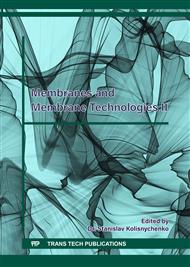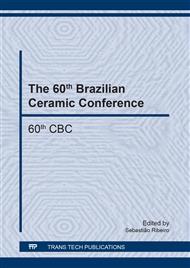p.234
p.240
p.245
p.251
p.257
p.263
p.269
p.274
p.280
Preparation and Characterization of Tubular Composite Membranes and their Application in Water Flow Measurements
Abstract:
The latest technologies require materials with combination of properties that are not usually found in conventional materials. Organic-inorganic hybrid materials emerge as alternatives to the synthesis of low cost new functional materials. The constituent polymer-clay nanocomposites are intended effectively for the treatment of oily effluents. The removal of oily effluents was evaluated using composite membranes with different nanocomposite percentages, consisting of a mineral clay BrasgelTM smaller than 2 μm and ultra high molecular weight polyethylene. The sample of clay was characterized by X-Ray Diffraction (XRD) and Cation Exchange Capacity (CEC), while the membranes by scanning electron microscope (SEM). The produced composite membranes efficiencies were evaluated by continuous flow for 1 hour. The results clearly confirmed that membranes incorporated with a higher percentage of nanocomposites achieved greater stability and less time as assessed in water flow.
Info:
Periodical:
Pages:
263-268
Citation:
Online since:
January 2018
Keywords:
Price:
Сopyright:
© 2018 Trans Tech Publications Ltd. All Rights Reserved
Share:
Citation:



